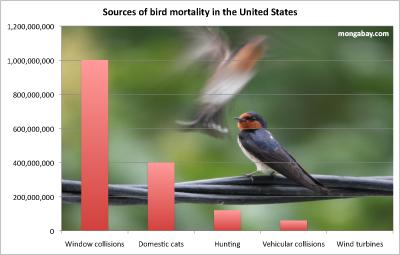The deaths of billions of birds annually due to collision with window glass can be reduced through simple measures including dimming lights in buildings at night, landscaping changes, and using window coverings that make glass more visible to birds, reports a bird expert writing in The Wilson Journal of Ornithology.
Conducting experiment with different types of firm on plastics and glass, Daniel Klem Jr., an ornithologist at Muhlenberg College in Allentown, Pennsylvania, found coverings that create visual “noise” can dramatically reduce bird-window collisions without drastically increasing costs or impeding visibility for humans relative to conventional glass. The most effective covering was a new exterior film with evenly spaced ultraviolet (UV)-reflecting and UV-absorbing patterns, which can be seen by birds but not humans.
“When this film is available for use it will save billions of bird lives annually after existing windows are retrofitted worldwide,” Klem told mongabay.com. “The long-term solution to saving birds from windows is to use similar effective patterns as a permanent coating to sheet glass used in new construction.”
|
|
Collisions are most frequent at ground level during daylight hours when birds mistake window reflections for habitat and fly into them, says Klem. But large numbers of birds are also killed flying into windows at greater heights.
“Birds behave as if windows are invisible,” he said.
Death from collisions with glass is thought to be the largest source of worldwide bird mortality after habitat loss. In the United States up to a billion birds a year are estimated to be killed in collisions, outranking deaths from domesticated cats (hundreds of millions), hunting (120 million), vehicular collisions (60 million), and encounters with wind turbines (400,000). Thus making windows more visible to birds could significantly contribute to reducing accidental bird death on a global scale.
But other measures can also cut collisions, according to Klem’s research in New York City during the 2006 and 2007 migration seasons. Klem and colleagues found that landscaping and architectural alterations, including eliminating shrubs and trees from areas in front of buildings, minimizing ground cover, and reducing the use of clear and reflective sheet glass, could save some of the estimated 34 million birds that perish annually in North American cities due to collisions with glass during the fall and spring migratory periods.
Other studies have shown that turning off building lights at night can also help birds, especially for migratory birds that fly under the cover of darkness and can be distracted from their flight paths by urban lights. A number of cities now promote programs to dim or turn off lights in office buildings at night to protect birds and conserve power.








